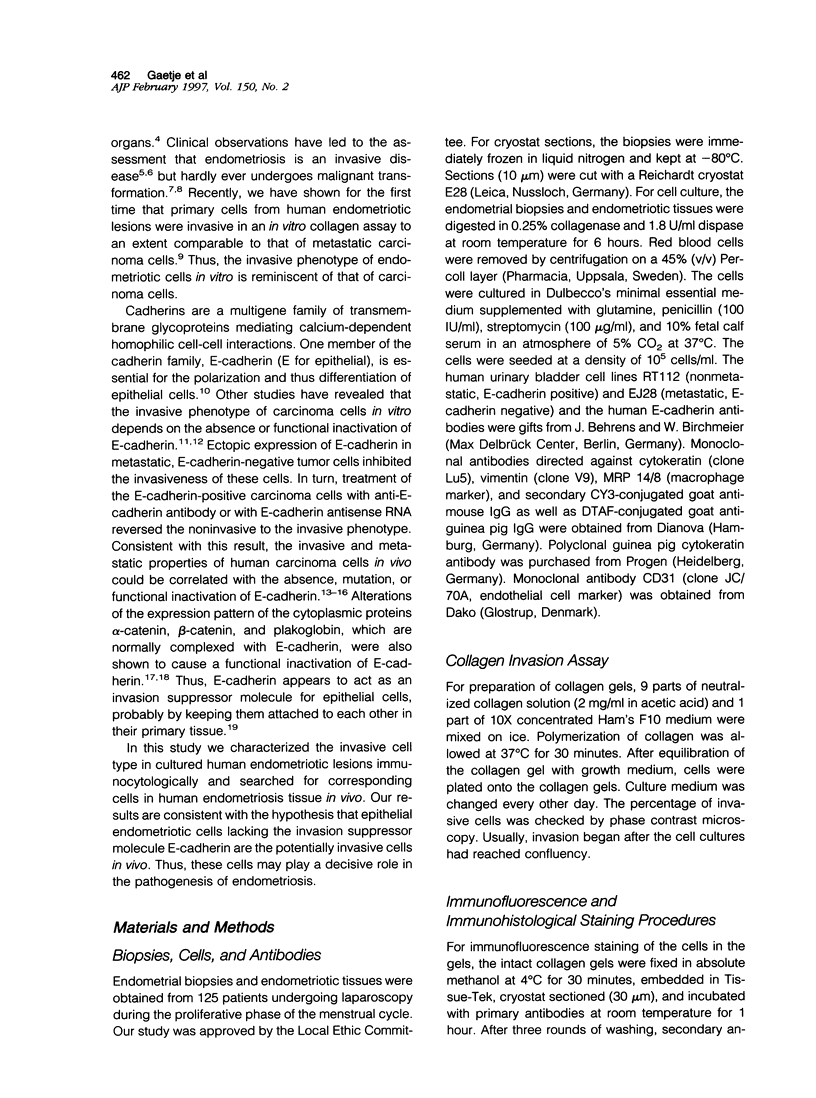Abstract
Endometriosis is one of the most frequent diseases in gynecology. It is a histologically defined nonmalignant disease in which endometrium-like tissue is found outside the uterus (for example, peritoneum, gut, or lung). The pathogenesis of endometriosis is unknown, but invasive mechanisms have been implicated in the development of the disease. Indeed, primary cells from human endometriotic biopsies but not from human endometrial biopsies are invasive in an in vitro collagen invasion assay. In this study, these in vitro invasive endometriotic cells were found to be nonmalignant epithelial cells lacking E-cadherin, which acts as an invasion suppressor molecule in carcinomas. Immunocytochemistry showed that the E-cadherin-negative epithelial cell type was increased in sections of endometriosis tissue as compared with sections of eutopic endometrium. On the basis of these data we propose that the E-cadherin-negative invasive endometriotic cells seen in vitro represent the cell population that migrates to ectopic (extrauterine) locations and thus causes endometriosis in vivo. Accordingly, the loss of E-cadherin expression is postulated to constitute a crucial mechanism in the pathogenesis of endometriosis.
Full text
PDF






Images in this article
Selected References
These references are in PubMed. This may not be the complete list of references from this article.
- Becker K. F., Atkinson M. J., Reich U., Becker I., Nekarda H., Siewert J. R., Höfler H. E-cadherin gene mutations provide clues to diffuse type gastric carcinomas. Cancer Res. 1994 Jul 15;54(14):3845–3852. [PubMed] [Google Scholar]
- Breen E., Clarke A., Steele G., Jr, Mercurio A. M. Poorly differentiated colon carcinoma cell lines deficient in alpha-catenin expression express high levels of surface E-cadherin but lack Ca(2+)-dependent cell-cell adhesion. Cell Adhes Commun. 1993 Dec;1(3):239–250. doi: 10.3109/15419069309097257. [DOI] [PubMed] [Google Scholar]
- Candiani G. B., Vercellini P., Fedele L., Colombo A., Candiani M. Mild endometriosis and infertility: a critical review of epidemiologic data, diagnostic pitfalls, and classification limits. Obstet Gynecol Surv. 1991 Jun;46(6):374–382. [PubMed] [Google Scholar]
- Fearon E. R., Vogelstein B. A genetic model for colorectal tumorigenesis. Cell. 1990 Jun 1;61(5):759–767. doi: 10.1016/0092-8674(90)90186-i. [DOI] [PubMed] [Google Scholar]
- Frixen U. H., Behrens J., Sachs M., Eberle G., Voss B., Warda A., Löchner D., Birchmeier W. E-cadherin-mediated cell-cell adhesion prevents invasiveness of human carcinoma cells. J Cell Biol. 1991 Apr;113(1):173–185. doi: 10.1083/jcb.113.1.173. [DOI] [PMC free article] [PubMed] [Google Scholar]
- Fujii S. Secondary müllerian system and endometriosis. Am J Obstet Gynecol. 1991 Jul;165(1):219–225. doi: 10.1016/0002-9378(91)90255-p. [DOI] [PubMed] [Google Scholar]
- Gaetje R., Kotzian S., Herrmann G., Baumann R., Starzinski-Powitz A. Invasiveness of endometriotic cells in vitro. Lancet. 1995 Dec 2;346(8988):1463–1464. doi: 10.1016/s0140-6736(95)92474-4. [DOI] [PubMed] [Google Scholar]
- Heaps J. M., Nieberg R. K., Berek J. S. Malignant neoplasms arising in endometriosis. Obstet Gynecol. 1990 Jun;75(6):1023–1028. [PubMed] [Google Scholar]
- Hülsken J., Behrens J., Birchmeier W. Tumor-suppressor gene products in cell contacts: the cadherin-APC-armadillo connection. Curr Opin Cell Biol. 1994 Oct;6(5):711–716. doi: 10.1016/0955-0674(94)90098-1. [DOI] [PubMed] [Google Scholar]
- Lanfrancone L., Pelicci G., Pelicci P. G. Cancer genetics. Curr Opin Genet Dev. 1994 Feb;4(1):109–119. doi: 10.1016/0959-437x(94)90099-x. [DOI] [PubMed] [Google Scholar]
- Liotta L. A., Steeg P. S., Stetler-Stevenson W. G. Cancer metastasis and angiogenesis: an imbalance of positive and negative regulation. Cell. 1991 Jan 25;64(2):327–336. doi: 10.1016/0092-8674(91)90642-c. [DOI] [PubMed] [Google Scholar]
- Matthews C. J., Redfern C. P., Hirst B. H., Thomas E. J. Characterization of human purified epithelial and stromal cells from endometrium and endometriosis in tissue culture. Fertil Steril. 1992 May;57(5):990–997. doi: 10.1016/s0015-0282(16)55014-6. [DOI] [PubMed] [Google Scholar]
- McNeill H., Ozawa M., Kemler R., Nelson W. J. Novel function of the cell adhesion molecule uvomorulin as an inducer of cell surface polarity. Cell. 1990 Jul 27;62(2):309–316. doi: 10.1016/0092-8674(90)90368-o. [DOI] [PubMed] [Google Scholar]
- Mostoufizadeh M., Scully R. E. Malignant tumors arising in endometriosis. Clin Obstet Gynecol. 1980 Sep;23(3):951–963. [PubMed] [Google Scholar]
- Osteen K. G., Hill G. A., Hargrove J. T., Gorstein F. Development of a method to isolate and culture highly purified populations of stromal and epithelial cells from human endometrial biopsy specimens. Fertil Steril. 1989 Dec;52(6):965–972. doi: 10.1016/s0015-0282(16)53160-4. [DOI] [PubMed] [Google Scholar]
- Risinger J. I., Berchuck A., Kohler M. F., Boyd J. Mutations of the E-cadherin gene in human gynecologic cancers. Nat Genet. 1994 May;7(1):98–102. doi: 10.1038/ng0594-98. [DOI] [PubMed] [Google Scholar]
- Sommers C. L., Gelmann E. P., Kemler R., Cowin P., Byers S. W. Alterations in beta-catenin phosphorylation and plakoglobin expression in human breast cancer cells. Cancer Res. 1994 Jul 1;54(13):3544–3552. [PubMed] [Google Scholar]
- Spuijbroek M. D., Dunselman G. A., Menheere P. P., Evers J. L. Early endometriosis invades the extracellular matrix. Fertil Steril. 1992 Nov;58(5):929–933. doi: 10.1016/s0015-0282(16)55437-5. [DOI] [PubMed] [Google Scholar]
- Umbas R., Schalken J. A., Aalders T. W., Carter B. S., Karthaus H. F., Schaafsma H. E., Debruyne F. M., Isaacs W. B. Expression of the cellular adhesion molecule E-cadherin is reduced or absent in high-grade prostate cancer. Cancer Res. 1992 Sep 15;52(18):5104–5109. [PubMed] [Google Scholar]
- Vleminckx K., Vakaet L., Jr, Mareel M., Fiers W., van Roy F. Genetic manipulation of E-cadherin expression by epithelial tumor cells reveals an invasion suppressor role. Cell. 1991 Jul 12;66(1):107–119. doi: 10.1016/0092-8674(91)90143-m. [DOI] [PubMed] [Google Scholar]
- Yoshiura K., Kanai Y., Ochiai A., Shimoyama Y., Sugimura T., Hirohashi S. Silencing of the E-cadherin invasion-suppressor gene by CpG methylation in human carcinomas. Proc Natl Acad Sci U S A. 1995 Aug 1;92(16):7416–7419. doi: 10.1073/pnas.92.16.7416. [DOI] [PMC free article] [PubMed] [Google Scholar]
- van der Linden P. J., de Goeij A. F., Dunselman G. A., van der Linden E. P., Ramaekers F. C., Evers J. L. Expression of integrins and E-cadherin in cells from menstrual effluent, endometrium, peritoneal fluid, peritoneum, and endometriosis. Fertil Steril. 1994 Jan;61(1):85–90. doi: 10.1016/s0015-0282(16)56457-7. [DOI] [PubMed] [Google Scholar]






